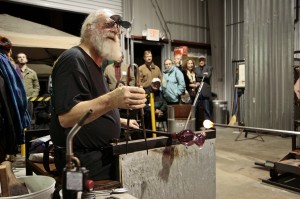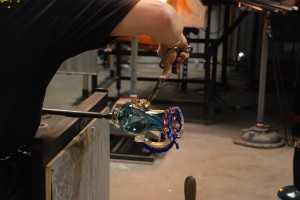Studio glass artist Fritz Dreisbach visited WCU on Monday, Oct. 29 and gave glass demonstrations at the Green Energy Park of Dillsboro.
“Glass is a fluid material and I want people to see it as still moving,” said Dreisbach, one of the founding fathers of the American Studio Glass Movement.
His original plan did not involve blowing glass. He comes from a family of art and math teachers, so he followed suit.
In an attempt to avoid being drafted in the Vietnam War, Dreisbach received his master’s in teaching at Oberlin College and taught high school math. He was not happy so he went back to school for a master’s in painting at the University of Iowa. It was there that he took his first glassblowing class.
In the summer of 1964, Dreisbach took the second glassblowing class ever taught in America. He noticed that in sculpture you have to force the material to bend, but in glassblowing, the heat does it and the fluidity had him hooked.
After receiving his master’s in painting, Dreisbach went to the University of Wisconsin in Madison to obtain a master’s of art in glassblowing and worked as an assistant to Harvey Littleton, a glass artist and educator.
Dreisbach is inspired by the physics and chemistry that go into making glass: “the color, light, transmission and absorption.” His love for the fluid motion of the pieces has stuck with him since he began blowing. He deems Claes Oldenberg, an American sculptor, as an influence to his work.
Glassblowing is a community-based art because it takes several people to make a piece. Sections of glass are made separately and then melted together to make a finished product.
The hierarchy of glass blowers while making a whole piece is centered around the head artist in charge, called the gaffer. He or she is the central figure and is the deciding factor in the artwork. Below them are the helpers that gather more molten glass and do the preliminary blowing for the gaffer, which controls the entire process and outcome.
In Dreisbach’s career, the most people he had helping him was ten. For Monday’s demonstration, four other people helped him create a colorful glass cup.
Dreisbach’s work resembles his personality. Just as his work flows, it is apparent in his manner, speech and way of life. He continues to push the limits of his artwork through other methods.
Dreisbach is currently experimenting with the process of cutting glass, which appears frozen. His use of the process challenges the physics of glassblowing while still having the glass appear fluid and free in the outcome.
The Fine Arts Museum hosted the opening of “North Carolina Glass 2012: In Celebration of 50 Years in Studio Glass in America” on Oct. 28. The gallery will feature over 20 glass artists including Harvey Littleton, Roger Parramore, and Richard Ritter.
“North Carolina Glass 2012 features both traditional glass blowing as well as new experimental forms that push the boundaries of studio glass, creating a dynamic experience for the viewer,” said Denise Drury, Interim Director of the Fine Art Museum.
“Throughout this exhibition, one will see a variety of styles, techniques and form created by several generations of North Carolina glass artists,” Drury said. The exhibit will run until Feb. 1, 2013.
Western Carolina University held its first exhibition of North Carolina Glass in 1974 by the efforts of Professor Joan Falconer Byrd.





